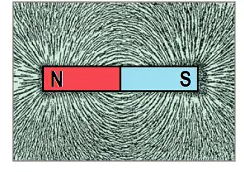| 2. | By convention a magnetic lines of force are considered to:
|
| 3. | Magnetic lines of force take the shortest possible path between the north and south poles of a magnet. However, when a material that can be magnetised is placed within the magnetic field, the field is distorted because a:
|
| 4. | Two magnetic fields acting in the same direction will:
|
| 5. | For a ferromagnetic material, the critical temperature above which the dipoles within the material become easy to realign is called the:
|
| 6. | When a magnet is attracted to a piece of magnetic material, the magnetic field passes through the material, turning it into a temporary magnet. This action is called:
|
| 7. | The three most important magnetic materials are iron, nickel and:
|
| 8. | One alloy that has made into permanent magnets with superior properties; is Alnico. This alloy consists mainly of:
|
| 9. | Ferromagnetic materials which are easily magnetised are called:
|
| 10. | When the magnetising force is removed from a magnetically soft material, the material tends to demagnetise itself. Any magnetism that remains is called:
|
| 11. | Ferrite magnetic materials are manufactured:
|
| 12. | Rare earth magnets make the strongest magnets currently available. One common application of these magnets is:
|
| 13. | When a device needs to be protected from a magnetic field, a magnetic shield is used. Magnetic shields divert the magnetic field by:
|
| 14. | Look at the following diagram: 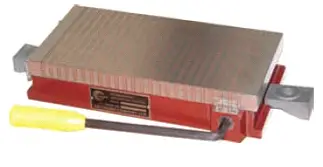 The above drawing shows a magnetic chuck which uses the holding power of magnets to retain magnetic materials firmly in position on the worktable of a machine during machining processes. One important advantage of the magnetic chuck is that:
|
| 15. | When current travels along a conductor, a magnetic field surrounds the conductor. This magnetic field:
|
| 16. | Electromagnets can replace permanent magnets in most applications, with the added advantage that electromagnets:
|
| 17. | The right-hand grip rule for straight conductors states that if the imaginary conductor is gripped with the thumb pointing in the direction of the current flow, then the fingers point in the direction of the:
|
| 18. | Look at the following diagram:  Using the right-hand grip rule for a straight conductor, the direction of the magnetic field in the above diagram will be:
|
| 19. | Look at the following diagram: 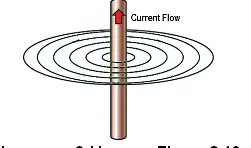 With reference to the above diagram, the strength of the magnetic field around a straight conductor depends on the value of the current in the conductor. Doubling the current results in:
|
| 20. | Look at the following diagram: 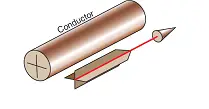 The above diagram illustrates the convention for indicating the direction of current flow in a conductor. The ¤ symbol indicates the current is flowing:
|
| 21. | By winding a conductor into a coil of many turns, the magnetic field strength is:
|
| 22. | The direction of the magnetic field generated by a solenoid can be determined using the right-hand grip rule. This rule states that when the right hand is placed over a solenoid coil so that the fingers point in the direction of the current flow, the thumb points in the direction of the:
|
| 23. | Look at the following diagram: 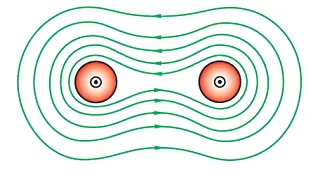 The above diagram shows the magnetic forces between two conductors carrying current in the same direction. This force causes the conductors to:
|
| 24. | Therefore, the magnetic force between two conductors with a known current flow in each conductor and with a known distance separating the conductors can be calculated from the formula:
|
| 25. | Two long parallel conductors 0.015 m apart each carry a current of 200 A in opposite directions. The force between them will be:
|
| 26. | The force required to create a magnetic field is called the:
|
| 27. | The magnetic field strength of a coil is proportional to the product of the:
|
| 28. | The following formula can be used to determine the magnetomotive force in a magnetic circuit: Fm = IN In the formula the symbol ‘N’ stands for the:
|
| 29. | A current of 7 A flows in a coil of 100 turns, the value of MMF creating a magnetic flux is:
|
| 30. | The magnetising force for a portion of a magnetic circuit is the MMF required to magnetise a unit length of a magnetic path and is expressed in:
|
| 31. | The flux density of a magnetic circuit is measured in:
|
| 32. | The flux density of a magnetic path can be found from the formula: In the formula the symbol Φ stands for:
|
| 33. | A magnetic circuit has a cross-sectional area of 100 mm2 and a flux density of 0.015T. The total flux in the circuit will be:
|
| 34. | A conductor carrying a current within a magnetic field will have:
|
| 35. | The value of the force on a conductor within a magnetic flux can be found from the formula, In the formula, the symbol B stands for:
|
| 36. | A conductor has been placed at right angles to a magnetic field with a flux density of 0.5 T over a length of 0.15 m of the conductor. If the current through the conductor is 15 A, then force exerted on the conductor will be:
|
| 37. | The permeability of a magnetic material is defined as the:
|
| 38. | The permeability of free space (a vacuum), is equal to:
|
| 39. | To find the actual permeability of a material, the following formula can be used: In the formula, the symbol μr is used for the:
|
| 40. | The term used to describe the opposition by a material to being magnetised is:
|
| 41. | The reluctance of a magnetic circuit depends on a number of factors. These are the length, the cross sectional area and the:
|
| 42. | The reluctance of a magnetic circuit can be found using the formula shown below. In the formula the symbol ‘A’ stands for the:
|
| 43. | An iron core has a total mean length of magnetic path of 250 mm. The core is rectangular in cross-section with dimensions 15 mm x 15 mm. The core has a relative permeability of 800 at the designed flux density. The reluctance of the core will be:
|
| 44. | The equivalent of Ohm’s Law for magnetic circuits is stated as: In the formula the term IN represents the:
|
| 45. | An electromagnet has 500 turns and the total reluctance of the magnetic core is 750 IN/Wb. The flux produced when 12 A flows through the coil will be:
|
| 46. | A contactor coil has 7000 turns and draws 0.12 A from the supply. When energised the total flux produced by the coil is 700 E-6 Wb. The magnetic reluctance of this circuit is:
|
| 47. | With reference to the magnetising characteristic of non-magnetic materials, the flux density ‘B’ varies directly with magnetising force ‘H’. Therefore the graph of ‘B’ against ‘H’ will be:
|
| 48. | B/H curves are commonly used as a means of comparing the:
|
| 49. | Look at the following graph: 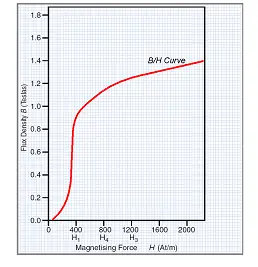 The B/H curve in the diagram above shows that when the value of H is low, small increases in the value of the magnetising force (H) will produce:
|
| 50. | With reference to the drawing shown above in QUESTION 49, as the magnetising force increases towards 2000 AT/m, the flux density increases less and less. This indicates that magnetic saturation is taking place. Saturation is said to occur at a flux density near the:
|
| 51. | Look at the following graph: 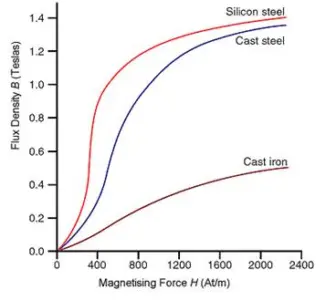 The graph illustrates the magnetisation curves for silicon steel, cast steel and cast iron. The curves show that silicon steel saturates at a:
|
| 52. | The graph in QUESTION 51 illustrates the magnetisation curves for silicon steel, cast steel and cast iron. The curves show that cast iron is:
|
| 53. | In electrical terminology term ‘hysteresis’ is used to describe the lag between a change in value or direction of the magnetising force and the:
|
| 54. | Even after the magnetising force is removed, some magnetism remains. This is known as:
|
| 55. | The force that is used to remove residual magnetism is known as the:
|
| 56. | Look at the following graph: 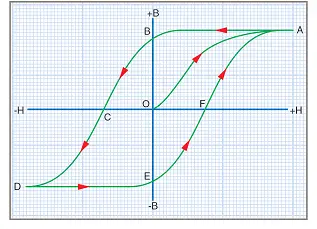 The graph represents the hysteresis loop of the magnetising force plotted against the flux density in both directions. On the graph, OB and OE indicate the values of:
|
| 57. | Reversing the magnetic field within the magnetic material results in the:
|
| 58. | Look at the following graph:  The graph compares the hysteresis loops of transformer steel and carbon steel. The hysteresis loop with the comparatively small area:
|
| 59. | Look at the following diagram: 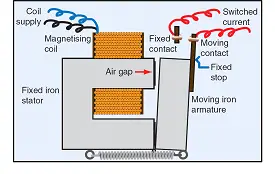 With reference to the magnetic circuit shown above, the total magnetic flux does not reach the air gap, but leaves the iron poles and passes through the surrounding air. The flux which leaves the main path is known as:
|
| 60. | Look at the following diagram: 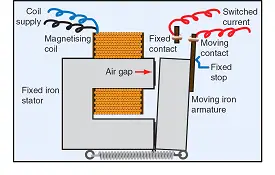 The above drawing shows a simple attracted-armature type of relay. When current flows in the operating coil, a magnetic flux is created:
|
| 61. | Some electrical machines are prone to failure when the supply voltage is lower than the value that the machine was designed for. No-volt relays, low-volt relays or brown-out relays, have an operating coil connected across the supply voltage. In these relays, the armature and contacts close when the:
|
| 62. | The operating coil of an overload relay is connected:
|
| 63. | Polarised relays operate only when:
|
